1. Aglietta M, Siciliano VI, Zwahlen M, Brägger U, Pjetursson BE, Lang NP, Salvi GE. A systematic review of the survival and complication rates of implant supported fixed dental prostheses with cantilever extensions after an observation period of at least 5 years. Clin Oral Implants Res. 2009; 20:441–451. PMID:
19522975.

2. Botelho MG, Ma X, Cheung GJ, Law RK, Tai MT, Lam WY. Long-term clinical evaluation of 211 two-unit cantilevered resin-bonded fixed partial dentures. J Dent. 2014; 42:778–784. PMID:
24685984.

3. Creugers NH, Käyser AF. An analysis of multiple failures of resin-bonded bridges. J Dent. 1992; 20:348–351. PMID:
1452875.

4. Durey KA, Nixon PJ, Robinson S, Chan MF. Resin bonded bridges: techniques for success. Br Dent J. 2011; 211:113–118. PMID:
21836574.

5. Marinello CP, Kerschbaum T, Pfeiffer P, Reppel PD. Success rate experience after rebonding and renewal of resin-bonded fixed partial dentures. J Prosthet Dent. 1990; 63:8–11. PMID:
2404111.

6. Lally U. Resin-bonded fixed partial dentures past and present--an overview. J Ir Dent Assoc. 2012-2013; 58:294–300.
7. Morgan C, Djemal S, Gilmour G. Predictable resin-bonded bridges in general dental practice. Dent Update. 2001; 28:501–506. 508PMID:
11862852.

8. Taşar S, Ulusoy MM, Merıç G. Microshear bond strength according to dentin cleansing methods before recementation. J Adv Prosthodont. 2014; 6:79–87. PMID:
24843391.

9. Langer A, Ilie N. Dentin infiltration ability of different classes of adhesive systems. Clin Oral Investig. 2013; 17:205–216.

10. Sol E, Espasa E, Boj JR, Canalda C. Effect of different prophylaxis methods on sealant adhesion. J Clin Pediatr Dent. 2000; 24:211–214. PMID:
11314145.
11. Chaiyabutr Y, Kois JC. The effects of tooth preparation cleansing protocols on the bond strength of self-adhesive resin luting cement to contaminated dentin. Oper Dent. 2008; 33:556–563. PMID:
18833862.

12. Saraç D, Bulucu B, Saraç YS, Kulunk S. The effect of dentin-cleaning agents on resin cement bond strength to dentin. J Am Dent Assoc. 2008; 139:751–758. PMID:
18519999.

13. Leirskar J, Nordbø H. The effect of zinc oxide-eugenol on the shear bond strength of a commonly used bonding system. Endod Dent Traumatol. 2000; 16:265–268. PMID:
11202892.

14. Prata RA, de Oliveira VP, de Menezes FC, Borges GA, de Andrade OS, Gonçalves LS. Effect of ‘Try-in’ paste removal method on bond strength to lithium disilicate ceramic. J Dent. 2011; 39:863–870. PMID:
22001411.

15. Santos MJ, Bapoo H, Rizkalla AS, Santos GC. Effect of dentin-cleaning techniques on the shear bond strength of self-adhesive resin luting cement to dentin. Oper Dent. 2011; 36:512–520. PMID:
21834711.

16. Grasso CA, Caluori DM, Goldstein GR, Hittelman E. In vivo evaluation of three cleansing techniques for prepared abutment teeth. J Prosthet Dent. 2002; 88:437–441. PMID:
12447222.

17. Gultz J, Kaim J, Scherer W. Treating enamel surfaces with a prepared pumice prophy paste prior to bonding. Gen Dent. 1999; 47:200–201. PMID:
10687499.
18. Duke ES, Phillips RW, Blumershine R. Effects of various agents in cleaning cut dentine. J Oral Rehabil. 1985; 12:295–302. PMID:
3862792.

19. Bavbek AB, Goktas B, Sahinbas A, Ozçopur B, Eskitascioglu G, Özcan M. Effect of different mechanical cleansing protocols of dentin for recementation procedures on micro-shear bond strength of conventional and self-adhesive resin cements. Int J Adhes Adhes. 2013; 41:107–112.

20. Button GL, Moon PC, Barnes RF, Gunsolley JC. Effect of preparation cleaning procedures on crown retention. J Prosthet Dent. 1988; 59:145–148. PMID:
3278095.

21. Feitosa VP, Ogliari FA, Van Meerbeek B, Watson TF, Yoshihara K, Ogliari AO, Sinhoreti MA, Correr AB, Cama G, Sauro S. Can the hydrophilicity of functional monomers affect chemical interaction? J Dent Res. 2014; 93:201–206. PMID:
24284259.
22. Van Meerbeek B, Yoshihara K, Yoshida Y, Mine A, De Munck J, Van Landuyt KL. State of the art of self-etch adhesives. Dent Mater. 2011; 27:17–28. PMID:
21109301.

23. Yoshihara K, Yoshida Y, Nagaoka N, Fukegawa D, Hayakawa S, Mine A, Nakamura M, Minagi S, Osaka A, Suzuki K, Van Meerbeek B. Nano-controlled molecular interaction at adhesive interfaces for hard tissue reconstruction. Acta Biomater. 2010; 6:3573–3582. PMID:
20346420.

24. Nikaido T, Ichikawa C, Li N, Takagaki T, Sadr A, Yoshida Y, Suzuki K, Tagami J. Effect of functional monomers in all-in-one adhesive systems on formation of enamel/dentin acid-base resistant zone. Dent Mater J. 2011; 30:576–582. PMID:
21946477.

25. Fukuda R, Yoshida Y, Nakayama Y, Okazaki M, Inoue S, Sano H, Suzuki K, Shintani H, Van Meerbeek B. Bonding efficacy of polyalkenoic acids to hydroxyapatite, enamel and dentin. Biomaterials. 2003; 24:1861–1867. PMID:
12615476.

26. Öztürk E, Bolay Ş, Hickel R, Ilie N. Shear bond strength of porcelain laminate veneers to enamel, dentine and enamel-dentine complex bonded with different adhesive luting systems. J Dent. 2013; 41:97–105. PMID:
22521701.

27. Boyer DB, Hormati AA. Rebonding composite resin to enamel at sites of fracture. Oper Dent. 1980; 5:102–106. PMID:
7015293.
28. Leas TJ, Hondrum S. The effect of rebonding on the shear bond strength of orthodontic brackets–a comparison of two clinical techniques. Am J Orthod Dentofac Orthop. 1993; 103:200–201.
29. Montasser MA, Drummond JL, Evans CA. Rebonding of orthodontic brackets. Part I, a laboratory and clinical study. Angle Orthod. 2008; 78:531–536. PMID:
18416614.
30. Eminkahyagil N, Arman A, CetinşZahin A, Karabulut E. Effect of resin-removal methods on enamel and shear bond strength of rebonded brackets. Angle Orthod. 2006; 76:314–321. PMID:
16539561.
31. Bishara SE, VonWald L, Laffoon JF, Warren JJ. The effect of repeated bonding on the shear bond strength of a composite resin orthodontic adhesive. Angle Orthod. 2000; 70:435–441. PMID:
11138647.
32. Wright WL, Powers JM. In vitro tensile bond strength of reconditioned brackets. Am J Orthod. 1985; 87:247–252. PMID:
3156504.

33. Jassem HA, Retief DH, Jamison HC. Tensile and shear strengths of bonded and rebonded orthodontic attachments. Am J Orthod. 1981; 79:661–668. PMID:
7015869.

34. Thomas BW, Hook CR, Draughn RA. Laser-aided degradation of composite resin. Angle Orthod. 1996; 66:281–286. PMID:
8863963.
35. Yap AU, Shah KC, Loh ET, Sim SS, Tan CC. Influence of eugenol-containing temporary restorations on bond strength of composite to dentin. Oper Dent. 2001; 26:556–561. PMID:
11699178.
36. Blixt M, Adamczak E, Lindén LA, Odén A, Arvidson K. Bonding to densely sintered alumina surfaces: effect of sandblasting and silica coating on shear bond strength of luting cements. Int J Prosthodont. 2000; 13:221–226. PMID:
11203636.
37. Fonseca RB, Martins LR, Quagliatto PS, Soares CJ. Influence of provisional cements on ultimate bond strength of indirect composite restorations to dentin. J Adhes Dent. 2005; 7:225–230. PMID:
16240963.
38. Zachrisson BU, Arthun J. Enamel surface appearance after various debonding techniques. Am J Orthod. 1979; 75:121–127. PMID:
369382.

39. Lohbauer U, Nikolaenko SA, Petschelt A, Frankenberger R. Resin tags do not contribute to dentin adhesion in self-etching adhesives. J Adhes Dent. 2008; 10:97–103. PMID:
18512506.
40. Toledano M, Osorio R, Perdigao J, Rosales JI, Thompson JY, Cabrerizo-Vilchez MA. Effect of acid etching and collagen removal on dentin wettability and roughness. J Biomed Mater Res. 1999; 47:198–203. PMID:
10449630.

41. Ayad MF, Rosenstiel SF, Hassan MM. Surface roughness of dentin after tooth preparation with different rotary instrumentation. J Prosthet Dent. 1996; 75:122–128. PMID:
8667268.

42. Peumans M, De Munck J, Fieuws S, Lambrechts P, Vanherle G, Van Meerbeek B. A prospective ten-year clinical trial of porcelain veneers. J Adhes Dent. 2004; 6:65–76. PMID:
15119590.







 PDF
PDF ePub
ePub Citation
Citation Print
Print







 XML Download
XML Download